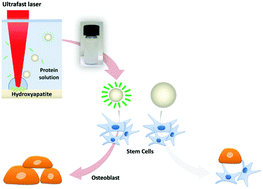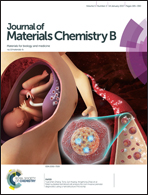Facile fabrication of bioactive ultra-small protein–hydroxyapatite nanoconjugates via liquid-phase laser ablation and their enhanced osteogenic differentiation activity†
Abstract
Hydroxyapatite bioactive complexes are being increasingly recognized as effective available means in regenerative medicine. Conventional technologies for their synthesis have drawbacks from a synthetic standpoint, mainly requiring high temperatures and multi-step processes. Here, we show that ultra-small hydroxyapatite conjugated-nanoparticles (Ha-CNPs) can be obtained at room temperature by Pulsed Laser Ablation (PLA) directly in protein solution using picosecond pulses at near infrared wavelengths. The results showed that the nanoparticle size was driven by the concentration of the protein. Using this approach, we obtained aqueous soluble and ultra-small crystalline nanoparticles of ≈3 nm diameter coated with protein molecules (surface coverage ≈ 5.5 pmol cm−2; zeta potential ≈−33.5 mV). These nanoparticles showed low cytotoxicity in vitro compared to chemically synthesized nanoparticles, and revealed proliferative and osteoinductive effects on human bone marrow mesenchymal stem cells (hMSCs). The resulting enhanced cell osteogenic differentiation suggested that our PLA-based synthetic approach might be exploited in novel applications of regenerative medicine.


 Please wait while we load your content...
Please wait while we load your content...